Thinking Out Loud: War Surplus Stories of the Golden Era
When a war ends it leaves a helluva mess.
Most of us Baby Boomers have next to no direct remembrance of WWII except for the stories told by parents and friends who were involved in it. However, it was next to impossible not to have the war surround us boomers as teenagers because of the massive amount of war surplus materials that were everywhere we looked.
When looking back at WW II production, the tendency is to think of the 300,000 aircraft produced (most of which wound up in well-known disposal yards) and nearly 50,000 Sherman tanks, etc., etc. What is seldom thought about is the unbelievable amount of “stuff” that had to be produced and then disposed of. All of the bigger pieces of hardware (airplanes, etc.) were surround by tens of thousands of tons mundane stuff that had served its purpose or were never used. All of that miscellaneous stuff was sold for pennies on the dollar and my dad, and his business was one of thousands of little businesses that took advantage of all the different “stuff” (there is no exact term that can encompass it all so “stuff” will have to suffice) that was being sold.
I don’t know if the material had to be bought by the train carload or not, but that’s how it often came to the House of Davisson in Seward, Nebraska. By the carload.
There was so much of it coming to his store I can’t remember it all. However, I clearly remember a carload of 3/16” thick 4’x 8’ mahogany plywood sheets. That’s a helluva lot of plywood! The net result was that most of the barns and farm buildings in the area wound up with mahogany interiors. I’m thinking they sold for $.20/sheet an equivalent today of about $2.50.
Then there were the 3” thick, foot-wide scaffolding planks. Those were healthy boards and were rough-sawn not planed. Some were very rough. Everything that came in carload quantities had been loaded at the source using tall forklifts and the boxcars were jammed to the roof and it was about 20 feet to the top of the car (a guess). How do you unload something like that without a similar forklift? You get inventive!
Our little town had a picturesque brick and stone depot with a good-sized concrete area beside the building. By that time, I was in my early teens and I’d be part of the brigade of workers and trucks we bought down there for unloading events. We’d back a tall box truck up to the train car door. Standing on top of that truck gave access to the top of whatever was in the boxcar. In this case it was rough planks. Guys on the top of the box truck pulled the planks out (I think they were baled so they had to cut the metal bands) and slid them down, a plank at a time, to a pick-up next to it. Two of us would be standing in the bed of the truck and would have a board handed down to us. We’d turn and hand It to another couple guys in a pick-up behind us. They’d stack the lumber in their truck and, when full, another pick-up would take its place. This sometimes took a couple of days.
The reason I so clearly remember unloading the planks is that, as one of them was handed down to us, I dropped it and, like an idiot, reflexively brought a leg up to break its fall. Dumb move! A sliver about the diameter of your little finger rammed right through the meat on the top of my leg. In one side and out the other! It broke off leaving what looked like a six-inch stake maybe half inch below the surface of my leg. Thinking back on it, I can see it like it happened yesterday. It was spectacular! It didn’t bleed as you’d expect and, oddly enough, it didn’t hurt all that much. However, the 14- or 15-year-old me wasn’t enjoying it and was on the edge of freaking out. However, being a country kid I’d had any number of similar things happen. In the emergency room, they had to slice down through the meat to lift the gigantic splinter out. I watched them do that and found it, especially the stitching, more fascinating than frightening.
That was a typical dumb-sh*t kid injury that just about all of us endured at the time. It was part of growing up. However, it seemed as if I specialized in that kind of event. At one of our high school reunions they had both the doctor and the chief of police who served during our time in school. Doc Carr had delivered most of us and during his speech he pointed at me and said “We stitched that one up so often we were thinking about buying a sewing machine.”
Some of the surplus stuff showed in four-foot cubes of wood-framed heavy cardboard. I remember them being packed with lots of shirts and pants, most olive-drab. These were not neatly folded, wrapped, sorted by size and stacked. They were just thrown into the cubes and you had to spread them out searching for the size. Dad just had them piled up on big tables.
A couple of particularly interesting cubes were jam packed, and I mean really “jammed” with flying helmets of all kinds. Obviously, the government literally shoveled them into the open cube and literally stomped them down. Every possible kind of helmet was in there from cloth summer helmets to fur lined leather ones. They ranged from early war training helmets to late war, high-altitude bomber/fighter helmets, some of which still had earphones in place.
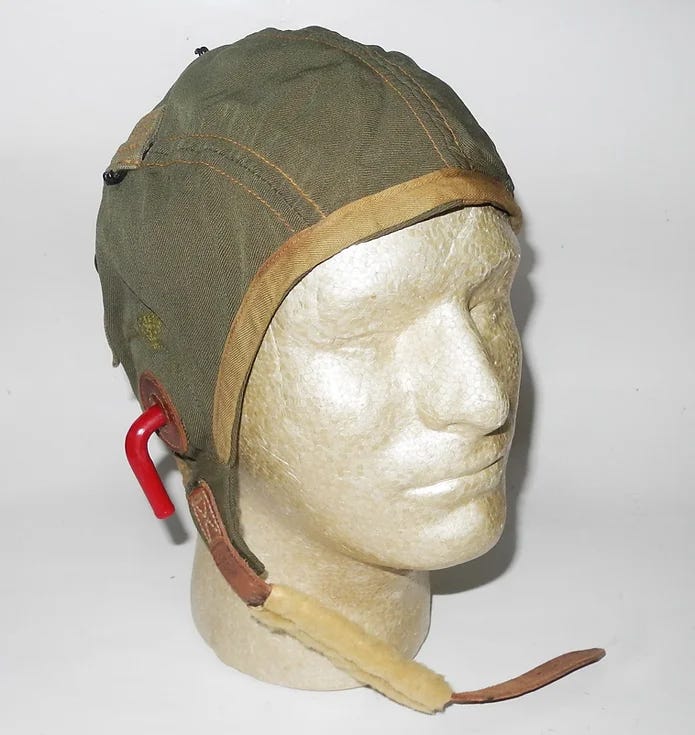
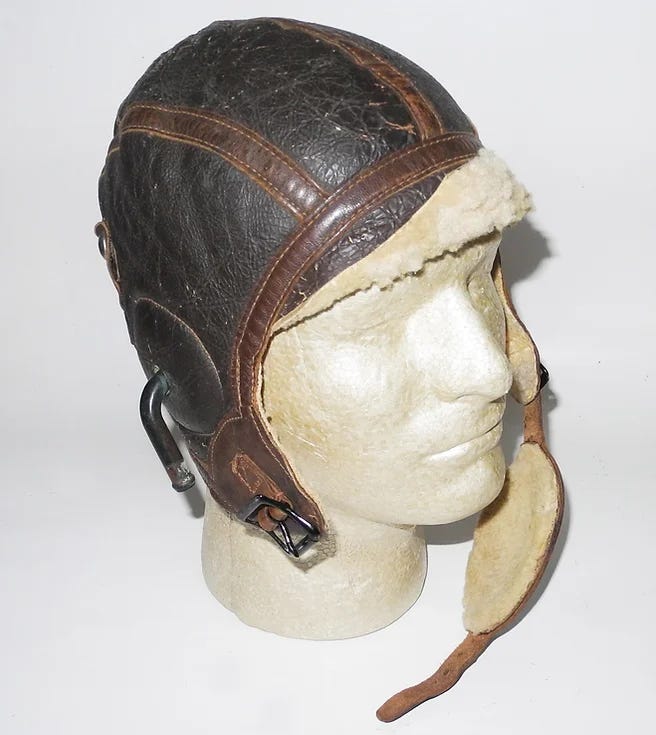
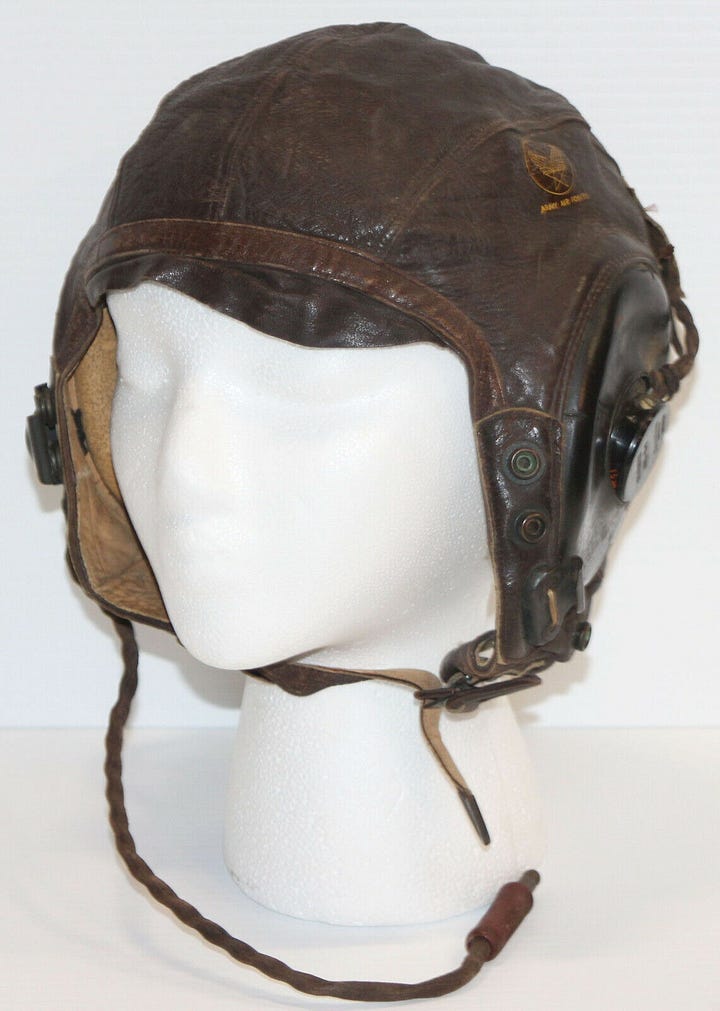
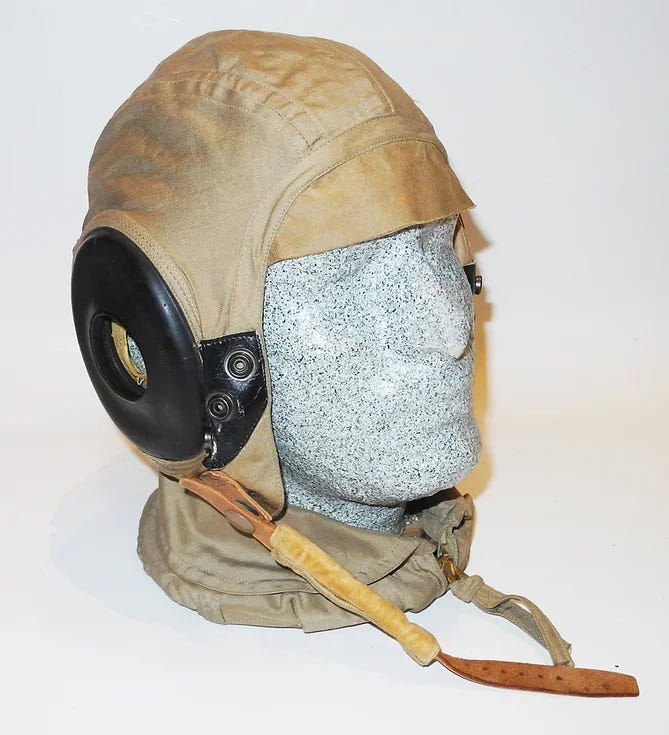
Training helmets were both cloth and leather for winter. Note the tubes coming out of the sides. Those were for the gosport intercom. The student was connected to the instructor by a tube that had a “funnel” in it for the instructor to yelled into. Or, if in a bad mood, spit into it. A11 leather helmet and the AN-15 helmets went into combat.
For years, you’d see farmers riding tractors in the fields wearing these helmets.
A couple of fascinating cubes were packed with flying jackets. Again, no particular type and, again, no effort at packing them. All were used but all cloth ones were at least washed. The leather ones varied tremendously in types and condition, but they were all priced around $2 ($25 today) so no one complained. I only remember there being Army Airforce types but no Navy G-1 jackets. I was riding motorcycles by then and absolutely wore out one of the B-3 Sheepskin jackets. It’s not unusual today to see USAAF A-2 jackets with patches and painting sell for $1,500-$6,000. They are definitely collector items.
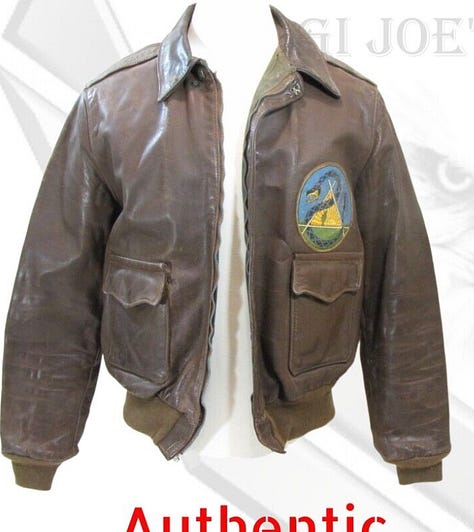
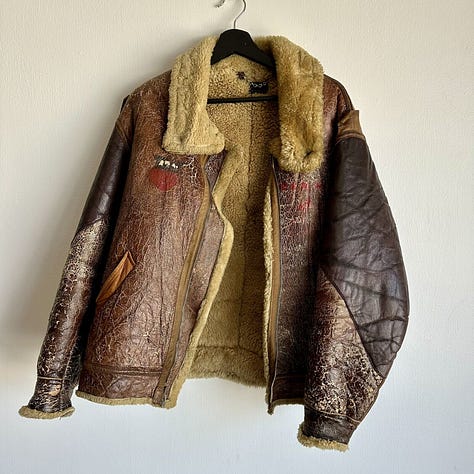
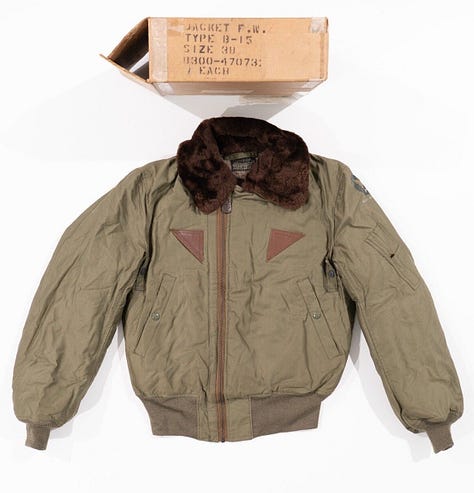
The A-2 was the most common the USAAF used and is the most now replicated, with the sheep skin B-3 being what has come to be known as the Bomber Jacket. Note the big patch on the left sleeve. Sheep skin was easily torn. Mine was mostly patches. In 1944 the cloth B-15 was introduced. I found this photo on eBay where the seller was asking “$36,300 or best offer.” Some guys have a sense of humor! Although this is new and never issued.
One of the more exotic bits of surplus stuff was a wooden crate that held 10 Winchester model 1892 rifles, not carbines. Apparently under Lend Lease the US had sent bunches of these to England who used them as home guard firearms. They were all 44 WCF (44-40) caliber, all in quite good condition and all missing firing pins which were easy to get. I think dad priced them around $12, which would be $140 today. They would sell for $1000+ today. I remember how they looked when the crate was opened. Do that today and it would cause heart attacks from excitement!
There also cubes of gloves of different types, none paired so it took some digging to match them up. I’ll bet there were 2,000 gloves in that cube. I dug out a pair of sheep skin mittens that had the trigger finger isolated. Worked great on bikes.
And then there were the hundreds of five-gallon fuel cans known then and today as Jerry cans, since the Germans first invented the type. They sold for nickels and dimes and went out the door like hot cakes
And the 10-foot wide target kites that had bold profiles of Messerschmitts and Zeros painted on them. They had rudders and control cables that came down to the flyer so he could make them zig and zag while trainees shot at them.
Cubes of white, soft canvas-like winter-camouflage hoodies sold like crazy too. Every school kid and farmer had to have one.
The school kid thing also applied to little leather boxes about six inches long that were for carrying ammo on your belt. I have no idea where they came from as they weren’t used by any American forces, but girls loved them as little purses.
And on and on. What I’ve chronicled happened in every town and city throughout the US. In those days “Army/Navy Surplus” stores were actually surplus stores. It was amazing what they’d be selling and they all had a distinctive “surplus” smell that any of us grey dogs can identify at first smell. It took decades for all that stuff to disappear. Longer for some of the big stuff.
I’m going paint a picture of a personal peek at long-lasting big stuff: It was 1963 or so and I was just finishing up my ratings at Oklahoma U. On one of my solo practice flights in a 7EC Champ I detoured out of the approved practice area and landed at Cimarron Field west of Oklahoma City. It had been a training field during the war but when I landed there it was mostly covered with junk.
Here's a word picture of the “junk”:
Picture three rows of deteriorating wooden crates. Each crate was about three feet wide, five feet tall and eight to ten feet long. They are stacked two wide and two high for something over 50 yards. There were three rows of them! The crates held Merlin engines and right and left hand Allisons. They were a mix of used and overhauled engines.
Next to the crates was a P-47M mostly stripped. Ahead of that was a P-38 also stripped reportedly the parts went to the Richard Bong Museum in MN. Next to them were over a dozen BT-13s sinking into the weeds. One of them gave up its bucket seats to go into my unfinished Model A hotrod roadster. I stumbled into some crates sinking into the weeds. Most held factory new Stearman wings. There was also a new B-17 dorsal fin in a crate.
WW II surplus was everywhere you looked and all of that stuff was melted down!!!
Those were the days! bd
PS - in a month or so I’m going to dig deep into what it took to clean up Europe when a war left it covered in junk. It’s interesting!




Budd....War surplus story.
Back in the early 60's I was flying A4's our of El Toro CA. My squadron buddy lived above a garage in Newport Beach. Across the alley the houses were on the water and across from his garage lived Paul Matz and his wife. When visiting with my buddy we met up with Paul and were invited into his house. We proceeded to his bar and Paul started tell us stories about his various exploits. Among them was how he got his big start in business. After the war he was looking at surplus airplanes in AZ and when looking at the B-17's he noticed they were full of fuel. He bid on a group of 17's using the value of the fuel as his price and was awarded the lot. He drained all the fuel, got his investment money back then parted out the engines, wheels, tires, etc., making huge profit. That was the first of a number of visits and related stories by him.....always accompanied with high dollar scotch whisky.
mb
Around 1962 my Dad flew home a P-51K he'd bought somewhere for $4000. He was later thrilled to sell it for $6000, which he reinvested in an FG-1D Corsair that eventually left, too, for something over $12,000 that he invested in a PAIR of Beech Staggerwings. Those were the days.